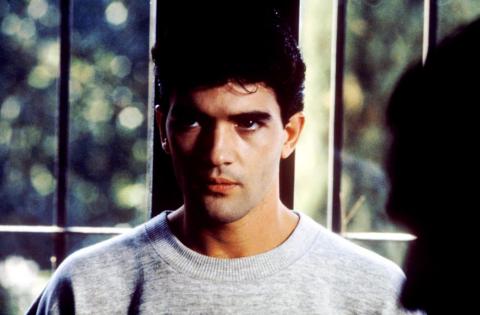Violence and Sex as Spectacle in Pedro Almodóvar's MATADOR

This essay on Matador was written by Erica Moulton, PhD candidate in UW Madison’s Department of Communication Arts. A 35mm print of Matador will screen in our Sunday Cinematheque at the Chazen "The Cinema of Pedro Almodóvar" series on Sunday, September 10 at 2 p.m.
By Erica Moulton
Throughout Pedro Almodóvar’s 1986 film Matador, comparisons are drawn between bullfighting and seduction. The film opens with a masterful intercut montage of a bullfighting lesson given by ex-matador Diego, and a female serial killer (María) luring an unsuspecting man to his death. Almodóvar cuts from Diego instructing his students where to sink their swords into the bull for the best kill to María driving her hairpin into the back of her lover’s neck mid-coitus. It’s a breathtaking sequence that sets the stage for the film that follows, one that explores the darkest impulses of its characters while also painting a vivid scene of post-Franco Spain. Matador is Almodóvar’s first truly cinematic film. As he grapples with themes of religion, misogyny, and the commodification of violence (especially against women), he also presents a beautiful film, full of vibrancy and color.
The film focuses on three characters, María (Assumpta Serna), Diego (Nacho Martinez), and Ángel, a student in Diego’s bullfighting academy played by a baby-faced Antonio Banderas. Banderas and Almodóvar had already collaborated four years prior in Labyrinth of Passion, and would work together several more times in the 1980s, with Almodóvar often casting Banderas as some type of lunatic. Matador is no exception, as Banderas plays a disturbed young man, twisted by his strict religious upbringing, whose obsessive desire to prove his masculinity leads him to rape Diego’s girlfriend in an early scene of the film. Almodóvar’s camera never looks away from any of the brutality depicted on screen, choosing to punctuate scenes of sexual violence with wide shots that emphasize the awkwardness of bodies. Wracked with guilt over the act he has committed, Ángel turns himself in for his crime. In the process, he is also accused of murdering several people, who are in fact the victims of Diego and María.
María volunteers to be Ángel’s lawyer, and a cat and mouse game ensues between her and Diego, as their violent passions draw them to discover the truth about each other. The film focuses on this tryptic of characters, and their desires and passions unfold in vivid detail. Diego, for instance, can only be sexually aroused by death, and forces his girlfriend to play dead while he makes love to her. In characteristic Almodóvar fashion, there is little attempt to explore the motivations of such behavior. Almodóvar is always more interested in the effect and less concerned with the cause. He is generally contemptuous of psychoanalysis, even to the extent of introducing a psychiatrist in the third act played by Almodóvar regular Carmen Maura, whose “treatment” of Ángel consists of her trying and failing to make romantic overtures and kissing him when he is unconscious.
Unlike Almodóvar’s earlier films which took inspiration from the punk movement of the 1970s that favored a loose and improvisational direction, this is his most controlled film to date. The violent spectacle is balanced by the look of the film, which relies on reds, pinks, and yellows (colors associated with bullfighting) to offset and perhaps underscore the brutality depicted onscreen. He incorporates the architecture of both new and old Madrid into his frames, shooting from a high-angle down a spiral staircase in one scene, or alternately from a low-angle looking up through a grated walkway in another scene. More attention is paid to the overall design and feel of each location—Diego’s house is cavernous and impersonal, while Ángel and his mother live in a sterile and neatly appointed apartment with little to no personal space. Even the door to the bathroom has a window, so Ángel’s mother is always watching him.
Almodóvar connects the bullfighting theme of spectacle to other realms of Spanish society, including the world of high fashion. In one very funny scene, Almodóvar makes a cameo as a pretentious fashion designer who barks instructions at the models backstage at a runway show that he tells a reporter is called “Spain Divided.” One of the models is Diego’s girlfriend Eva, who is dressed in a red wedding dress with blood painted running down her face. Almodóvar as the fashion designer hands her a gun and tells her to use it at the end of the show. Later in the film, Almodóvar shows Diego watching a VHS tape of himself being gored by a bull, the crowd looking on as his bedecked body is tossed about like a rag doll for their entertainment.
The characters in Almodóvar’s films operate on the extreme ends of the spectrum of human behavior. In Matador, they commit horrific acts of rape and murder. They behave in strange and unpredictable manners. Almodóvar’s filmmaking doesn’t elucidate their behavior, but beginning with Matador, he brings a level of sophistication and visual pleasure to his stories that make their subject matter all the more troubling and engaging. Almodóvar has been alternately labeled a “women’s filmmaker” and a filmmaker who traffics in female suffering. Reviewing Matador for the New York Times, critic Vincent Canby called Almodóvar “Spain’s most reputable disreputable film maker.” He has certainly earned all of these labels, and his films, including and especially Matador, deserve to be watched and re-watched, studied, and most of all, debated.
